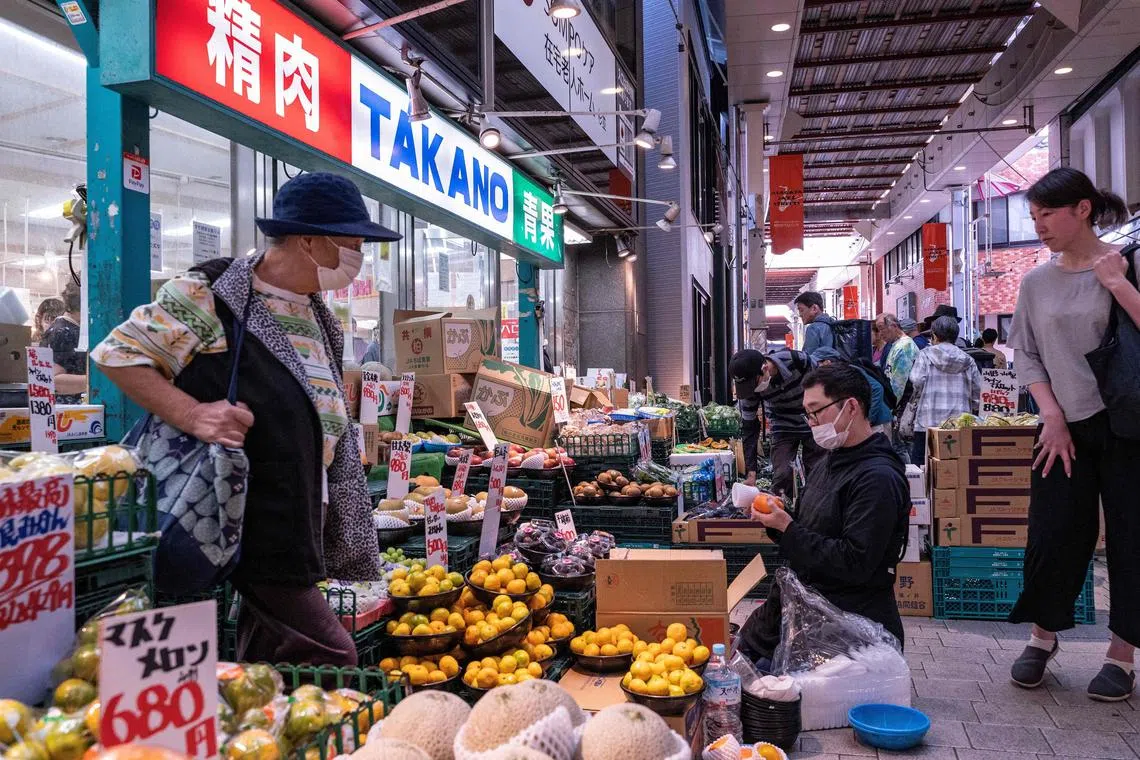Japan’s inflation cools as BOJ waits for wage gains to kick in
Sign up now: Get ST's newsletters delivered to your inbox

The Japanese yen’s recent depreciation fuels concerns that cost-push inflationary pressures may be here to stay.
PHOTO: AFP
Follow topic:
Japan’s inflation cooled for a second month while staying above the Bank of Japan’s (BOJ) price target as the yen’s recent depreciation fuels concerns that cost-push inflationary pressures may be here to stay.
Consumer prices excluding fresh food rose 2.2 per cent in April from a year ago, the Ministry of Internal Affairs said on May 24. The reading matched analysts’ estimates. The gauge stayed at or above the BOJ’s 2 per cent target for a 25th month.
The biggest factor weighing on the index was a deceleration in gains for processed food prices. They slowed to 3.5 per cent partly due to base effects, after those prices jumped a year earlier in a sign businesses were becoming more willing to pass on rising costs to consumers.
Lodging costs also advanced at a smaller pace, exerting a drag on the overall gauge.
A deeper measure of inflation that strips out fresh food and energy prices cooled to 2.4 per cent, also in line with the consensus estimate.
The results alone are not likely to derail the BOJ from pursuing opportunities to further roll back its easy policy settings. BOJ watchers have increasingly flagged the risk of an early rate hike as the yen stays near a 34-year low even after the government was suspected of conducting market intervention to support the currency on two occasions.
Service prices, which the BOJ has highlighted as a key factor in its policy deliberations, rose 1.7 per cent from a year earlier, decelerating from 2.1 per cent in the previous month. Economists are paying greater attention to May’s data as April marks the start of the fiscal year, when many companies consider implementing price changes.
The trend may turn in coming months when many firms start to implement wage hikes. The nation’s biggest umbrella group for unions has won pledges for increases exceeding 5 per cent from large companies, the biggest gains in more than three decades. The BOJ is hopeful those extra wages will spur spending and prices.
“I think that from here on out, wage increases will steadily exert pressure to raise prices, both in terms of demand and also in terms of supply,” said Nomura Securities senior economist Kohei Okazaki. “Our main scenario is that this will occur to some extent.”
Tokyo’s inflation, a leading indicator for national figures, registered a surprise plunge in April after the local government began giving education subsidies. Analysts including those at NLI Research Institute estimated that the impact of those measures was much smaller for the national gauge, trimming price gains by about 0.1 percentage point or less.
Subsidies for utilities subtracted 0.48 percentage point from the headline consumer price index gauge. The government will begin phasing out those outlays from May, potentially pushing up the nation’s key inflation gauge towards 3 per cent over the summer.
Japanese businesses are increasingly having to weigh whether to raise prices to pass on rising costs resulting from the weak yen, even as consumer spending remains lacklustre. Household spending has retreated for 13 months, as a persistent decline in real wages undermines shoppers’ propensity to spend.
Japan’s economy contracted in the first quarter of 2024, stretching the string of quarters with zero or negative growth to three, according to a government report in May. A key missing piece of the economic puzzle is personal spending, which fell for a fourth straight quarter.
The economy’s poor start to the year will not nudge the central bank off the path towards another interest rate hike because a growth rebound is anticipated, BOJ governor Kazuo Ueda said on May 23.
“There is no change in an overall picture so far” for a recovery, he told reporters in Italy ahead of a meeting of Group of Seven finance authorities in Stresa.
The yen weakened beyond 160 to the US dollar in late April 2024. That move was followed by two currency interventions by the Finance Ministry to support the yen, according to a Bloomberg analysis of central bank data. The government has not confirmed those actions.
There are growing concerns over the yen. About 64 per cent of firms said the recent depreciation has eroded profits, according to a report last week by Teikoku Databank. Mr Ken Kobayashi, head of Japan’s chamber of commerce, has called for the authorities to take steps to move the yen to around 120 to 130 per US dollar.
Economists have flagged the risks that the weak yen could drive a resurgence in cost-push inflation, dealing a fresh blow to consumption as shoppers tighten budgets.
Against that backdrop, and with the yen having lost ground after he earlier showed little concern, Mr Ueda has recently shifted his tone when speaking about the foreign exchange market. Earlier in May, he said rapid currency moves are undesirable, sending a clear warning after a meeting with Prime Minister Fumio Kishida. BLOOMBERG

